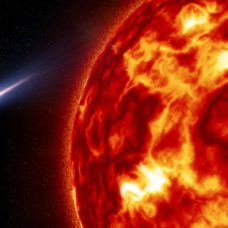The U.S. National Space Agency and Europe Space Agency have launched their joint Solar Orbiter mission.
Yesterday, a spacecraft that’s designed to study the Sun lifted off from Cape Canaveral atop an Atlas V 411 rocket.
The probe is set to enter the Sun’s orbit after a two-year, gravity-assisted journey from Earth and Venus. Upon reaching its destination, the solar orbiter would take up a highly elliptical orbit.
So, unlike the surrounding planets, the probe would not orbit in a flat plane. Instead, it’ll use Venus’ gravity to raise its orbit continually, and study the Sun at a higher altitude.
During the seven years of the mission, the solar orbiter should reach a latitude of 25 degrees. However, a mission extension could raise the latitude further to as high as 34 degrees.
As a result, scientists can get a unique perspective of our star. The solar orbiter will be able to collect images and data from the Sun’s polar region that no spacecraft have managed to gather.
Along with providing a new perspective of the Sun, the mission could also help us understand the solar winds it sends blowing into space.
In a statement, NASA’s associate administrator for Science at the agency’s headquarters in Washington, Thomas Zurbuchen said:
“Together with our European partners, we’re entering a new era of heliophysics that will transform the study of the Sun and help make astronauts safer as they travel on Artemis program missions to the Moon.”
A Joint Solar Orbiter Mission to Understand the Heliosphere
The researchers equipped the solar orbiter with tools to investigate how the Sun generates the heliosphere. Aside from a heat shield, the probe consists of ten other instruments.
These include magnetometers, energy particle detectors, a solar wind plasma analyzer, a spectral imaging device, a heliospheric imager, among others.
Since the orbiter is flying as close as 42 million km to the Sun, most of its scientific activities will occur nearby. Ultimately, the probe can measure the solar wind, the solar energetic particles, the Sun’s heliospheric magnetic field from close proximity.
Researchers hope that the close approaches would provide a view of the polar region. And this, in turn, would contribute to our understanding of the solar dynamo, a physical process that gives rise to the Sun’s magnetic field.
Now, the solar orbiter has successfully deployed its solar array in space and ready to enter cruise mode.
Scientists expect that the solar orbiter will encounter the first of its close solar passes at the end of May 2022. That’s six months after emerging from cruise-mode.



















Comments (0)
Least Recent